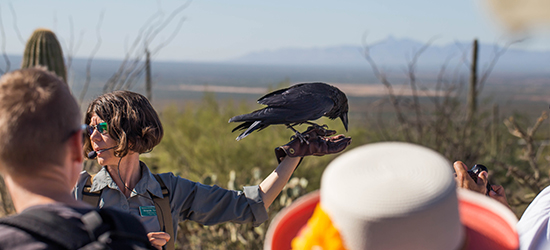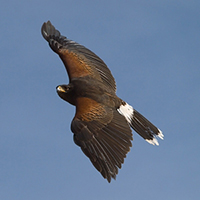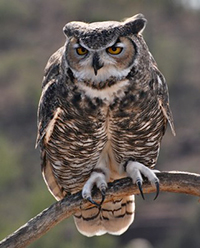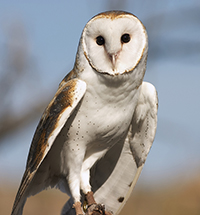The Coati (co-AH-tee) is a relative of the raccoon with a long nose, masked face, and a striped tail. Coatis are curious and energetic, just like kids!
Coati Club News, December 2017
Raptors Above!
Have you ever seen hawks circling high in the sky? At the Desert Museum from October to April you can see soaring hawks and more at the Raptor Free Flight Program. Raptors are birds like eagles, hawks, falcons, and owls that hunt live prey. They have many adaptations for hunting such as excellent eyesight, talons (claws) to catch and hold their prey, and curved beaks perfect for tearing meat.
As you watch, you’ll see raptors fly high and sometimes low, even feeling the brush of feathers as they swoop just overhead. They might land on top of a saguaro cactus, tree branches, or on the closed fist of one of their handlers who wear long leather gloves to protect themselves from the birds’ sharp, strong talons.

During Raptor Free Flight, the birds don’t do tricks. Instead, they show their amazing natural behaviors as they soar, dive, perch, and interact with each other or other wildlife in the demonstration area. These magnificent birds help teach people about their species so we can appreciate and help protect them.
Come to the Raptor Free Flight at 10 a.m. or 2 p.m. daily from October to April, and you may get a chance to see some of these stars of the program.
Harris’s Hawks

These medium-sized hawks are brownish-red all over except for a white rump patch and white-tipped tail. They also have long yellow legs. Harris’s Hawks are found in the U.S. only in southern Arizona, New Mexico, and Texas, and then south through Mexico and into South America. These birds are called the “wolves of the air” because they live and hunt together in family groups of three to seven birds. They work together to protect their territory, care for the young, and hunt cooperatively, sharing their food. They hunt ground squirrels, cottontails, jackrabbits, reptiles, insects, and other birds. Look for them in the 2 p.m. demo!
Great Horned Owls

The largest owl in our area, Great Horned Owls can be 2 feet tall, with ear tufts, grey-brown feathers, and a white throat that looks like a collar. During the day, they roost in places like tall trees or rocky overhangs. They may be hard to spot at rest because their grey-brown feathers provide camouflage. By night they use their excellent night vision and hearing to find a wide variety of prey including birds, snakes, rodents, rabbits, toads, tarantulas, and even skunks!
In late January and February in the Sonoran Desert you can hear Great Horned Owls hoo hoo hooting at night, as they search for a mate. They can nest on tall rocky ledges, in the arms of a saguaro cactus, and even in the rafters of abandoned buildings. Parents take turns sitting on 2-6 eggs. After about a month, the eggs hatch and the parents’ job becomes feeding and protecting their young babies.
Barn Owls

Barn Owls are the second largest owls in the Sonoran Desert. They also have excellent night vision. But they depend even more on their remarkable hearing. Like other owls, their facial disc feathers channel sounds into their ears. Unlike other owls, one ear is slightly higher than the other. This lets them catch prey just with their hearing alone. They can hunt in the darkest time of night.
Other stars of the Raptor Free Flight program include a Gray Hawk, Ferruginous Hawk, Red-Tailed Hawk, Peregrine and Prairie Falcons, and a pair of Chihuahuan Ravens.
Fun Facts:
- A hawk can spot a rabbit hopping through the brush from about a mile away.
- The word raptor comes from the Latin for “to seize” — because that is what raptors do to their prey with their talons.
Raptor Crafts
Barn Owl Jack o Lantern
Barn Owls are sometimes called ghost owls. Unlike the “hoo hoo” sound of the Great Horned Owl, they make an eerie, screaming call. And with their silent flight and white undersides, they may look like a ghost in the night. Print out the barn owl pattern and use it as a guide to make a super scary barn owl jack o lantern! Draw the owl face on your pumpkin with ink. Make sure you make the lines thick like they are in the drawing. Then, with the help of an adult, carve a circle in the top of the pumpkin to make a lid to get the seeds out. Carve out the inked parts that you drew. Insert a candle, and voila, a barn owl can glow on your porch!
Raptor Window Silhouette
The windows of our houses and other buildings can be dangerous for birds. On sunny days, they reflect the sky and plants around the building and look like sky and plants, not a solid window. The birds fly into them and can be stunned or even killed. But we can help birds avoid our windows. Taping paper bird silhouettes to our windows breaks up their mirror-like quality and helps the birds to see them.
Print the raptor silhouette pattern. Cut out the black raptor and tape it to your window, or use it as a model to make more raptors. Trace around it onto colorful construction or other paper and cut out the raptor shape to tape to your window.
Photo credits: Trainer with Chihuahuan Raven - Liz Kemp, Harris's Hawk - Michael Mueller, Great Horned Owl - Angella Parker, Barn Owl - Rhonda Spencer.
